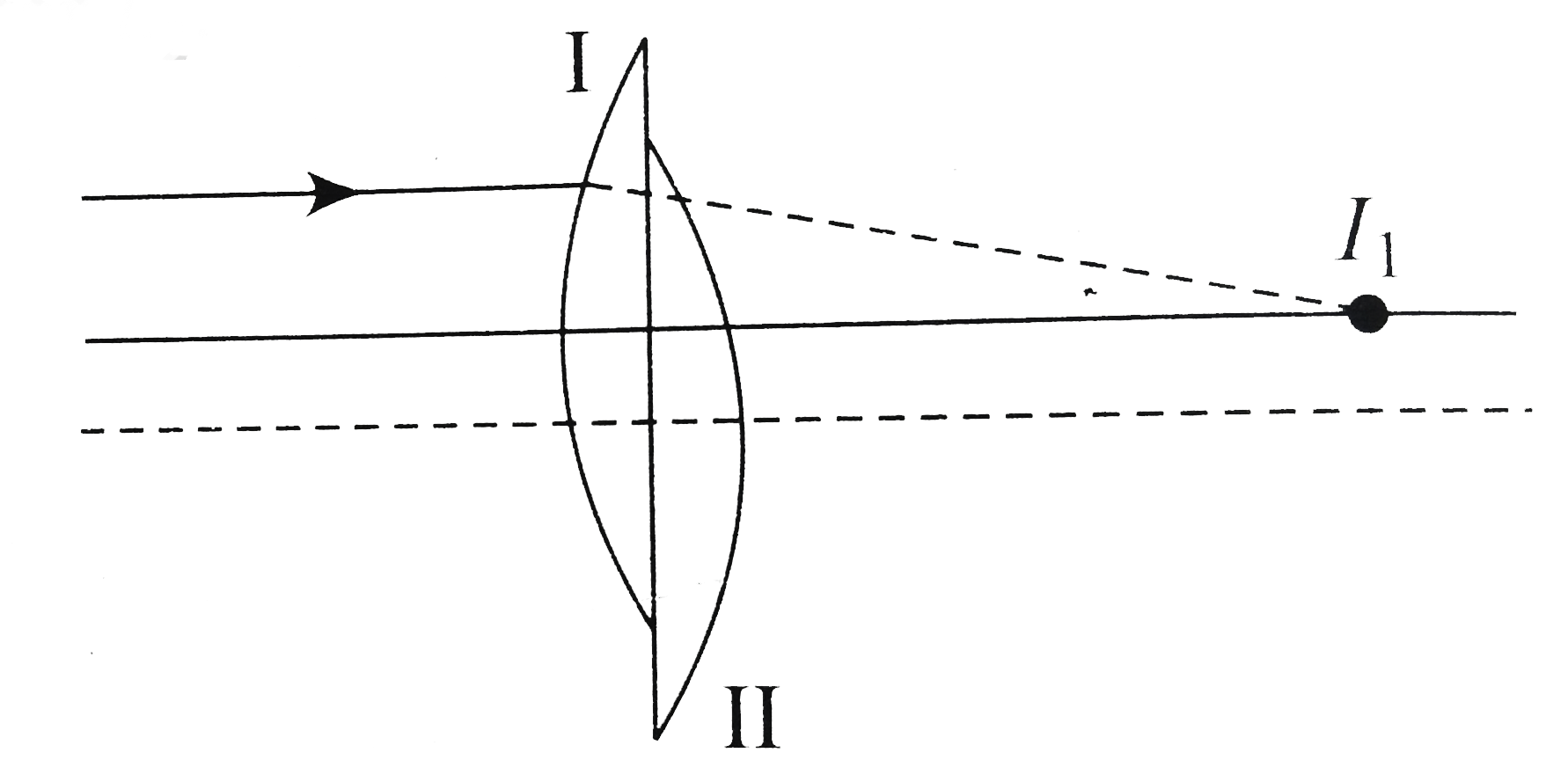Two identical plano-convex lenses L1(μ1−1.4) and L2(μ2−1.5) of radii of curvature R=20cm are placed as shown in Figure.

Q. Now, the secocnd lens is shifted vertically downward by a small distance 4.5mm and the extended parts of L1 and L2 are blackened as shown in figure. Find the new position of the image of the parallel beam.

200/9 cm behind the lens 2.5 mm below the principal axis of L1
100/9cm in front of th elens 2mm below the prinicipal axis of L1
200/9cm in front of the lens 2.5mm below the principal axis of L1
100/9cm behind the lens 2mm below the princiipal axis of L1
The correct Answer is:a.
a. Focal lengths of lenses L1 and L2 are, respectively, given by
1f1=(μ−1)(1R−1∞)⇒f1=50cm
1f2=(μ−1)[1∞−(−1R)]⇒f2=40cm
The equivalent focal length f of the combination is given by
1f=1f1+1f2⇒f=2009cm
Hence, the image of the parallel beam is formed on the common principal axis at a distance of 22.22cm from the combination on the right side.
b. Image formed by L1 is at a distance of 50cm behind the lens. This image lies on the principal axis of L1 and will act as an object for L2
For L2, object distance, u=+50cm
f2=+40cm
1υ−1u=1f⇒μ=2009cm
Magnification caused by L2,m=υu=49
For L2 object I1 is at a distance of 4.5mm above its principal axis.
Hence, distance of image I2 of the object (virtual) I1 is at a distance (4/9)×4.5=2mm above the principal axis of L2
[∴height of image=m×height of object]
Hence, final image is at a distance of 22.22cm behind the combination at a distance of 2.5mm below the principal axis of L1.

Topper's Solved these Questions
- BOOK - CENGAGE PHYSICSCHAPTER - GEOMETRICAL OPTICSEXERCISE - Integer15videos
GEOMETRICAL OPTICS
- BOOK - CENGAGE PHYSICSCHAPTER - GEOMETRICAL OPTICSEXERCISE - Archives7videos
GEOMETRICAL OPTICS
- BOOK - CENGAGE PHYSICSCHAPTER - GEOMETRICAL OPTICSEXERCISE - Assertion-Reasoninig2videos
GEOMETRICAL OPTICS
- BOOK - CENGAGE PHYSICSCHAPTER - FRICTIONEXERCISE - QUESTION BANK1videos
FRICTION
- BOOK - CENGAGE PHYSICSCHAPTER - GRAVITATIONEXERCISE - Question Bank39videos
GRAVITATION
Similar Questions
Two identical plano-convex lenses L1(μ1−1.4) and L2(μ2−1.5)
of radii of curvature R=20cm are placed as shown in Figure.

Q. Find the position of the image of the parallel beam of light relative to the common principal axis.View SolutionTwo identical concex lenses L1andL2are placed at a distance of20cmfrom each other on the common principal axis .The focal length of each lens is 15cmand the lensL2is to the right of lensA.A point object is placed at a distance of 20cmon the left on lensL1on the common axis of two lenses.Find where a convex mirror of radius of curvature5cmshould be placed so that the final image coincides with the object.?
View Solution
Knowledge Check
- Question 1 - Select One
Two identical plano-convex lenses L1(μ1−1.4) and L2(μ2−1.5)
of radii of curvature R=20cm are placed as shown in Figure.

Q. Find the position of the image of the parallel beam of light relative to the common principal axis.A100/7cmB200/9C31.2cmD21.8cm - Question 2 - Select One
In the circuit shown in Fig. If both the lamps L1 and L2 are identical.
 Atheir brightness will be sameBL1 will be brighter than L2CAs the frequency of supply voltage in increased, brightness of L1 will increase and that of L1 will decreaseDOnly L2 will glow because the capacitor has infinite resistance
Atheir brightness will be sameBL1 will be brighter than L2CAs the frequency of supply voltage in increased, brightness of L1 will increase and that of L1 will decreaseDOnly L2 will glow because the capacitor has infinite resistance - Question 3 - Select One or More
In the circuit shown in the figure, if both the lamps L1 and L2 are identical
 ATheir brightness will be sameBL2 will be brighter than L1CAs frequency of supply voltage is increased brightness of L1 will increase and that of L2 will decreaseDOnly L2 will glow because the capacitor has infinite resistance.
ATheir brightness will be sameBL2 will be brighter than L1CAs frequency of supply voltage is increased brightness of L1 will increase and that of L2 will decreaseDOnly L2 will glow because the capacitor has infinite resistance.
A plano-convex glass lens (μg=3/2) of radius of curvatureR=10cm is placed at a distance of b from a concave lens of focal length 20cm. What should be the distance a of point object O from the plano-convex lens so that position of final image is independent of b?
 View Solution
View SolutionA plano-convex glass lens (μg=3/2) of radius of curvatureR=10cm is placed at a distance of b from a concave lens of focal length 20cm. What should be the distance a of point object O from the plano-convex lens so that position of final image is independent of b?
 View Solution
View SolutionIn the figure shown, there are two convex lenses L1 and L2 having focal. Lengths f1 and f2 respectively. The distance between L1 and L2 will be
 View Solution
View SolutionIn the figure shown, there are two convex lenses L1 and L2 having focal. Lengths f1 and f2 respectively. The distance between L1 and L2 will be
 View Solution
View SolutionA double convex thin lens made of glass (refractive index μ=1.5) has both radii of curvature of magnitude 20 cm . Incident light rays parallel to the axis of the lens will converge at a distance L such that
View Solution
